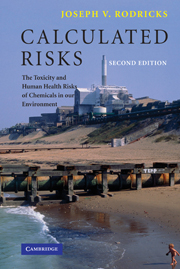Book contents
- Frontmatter
- Contents
- Preface to the first edition
- Preface to the second edition
- List of abbreviations
- Prologue
- 1 Chemicals and chemical exposures
- 2 From exposure to dose
- 3 From dose to toxic response
- 4 Toxic agents and their targets
- 5 Carcinogens
- 6 Identifying carcinogens
- 7 Risk assessment I: some concepts and principles
- 8 Risk assessment II: applications
- 9 Risk assessment III: new approaches, new problems
- 10 Risk assessment IV: the courtroom
- 11 The management of risk
- 12 A look ahead
- Sources and recommended reading
- Index
4 - Toxic agents and their targets
Published online by Cambridge University Press: 25 August 2009
- Frontmatter
- Contents
- Preface to the first edition
- Preface to the second edition
- List of abbreviations
- Prologue
- 1 Chemicals and chemical exposures
- 2 From exposure to dose
- 3 From dose to toxic response
- 4 Toxic agents and their targets
- 5 Carcinogens
- 6 Identifying carcinogens
- 7 Risk assessment I: some concepts and principles
- 8 Risk assessment II: applications
- 9 Risk assessment III: new approaches, new problems
- 10 Risk assessment IV: the courtroom
- 11 The management of risk
- 12 A look ahead
- Sources and recommended reading
- Index
Summary
A complete treatment of the subject of this chapter would require many volumes. There are some toxicological data available on over 20 000 industrial chemicals, including pharmaceuticals and consumer products of all types, although for a very large proportion of these the data reflect only relatively short-term, high-dose exposures. The number for which both comprehensive animal and epidemiological studies are available probably does not exceed a few hundred. The rest have some intermediate degree of toxicological characterization. The data base is growing all the time and new regulatory initiatives, especially in the EU, are intended to accelerate that growth in the near future.
Numerous compendia are available and can be consulted if there is a need to acquire comprehensive knowledge on specific substances (see Sources and recommended reading). The intention of this chapter is not to provide anything even remotely complete about any given chemical. It is instead simply to illustrate with concrete examples the many toxicological principles and concepts we have been discussing, and to show the diverse ways chemicals of many different types can bring about harm, and the conditions under which they do so. We cover most of the significant targets of toxicity, provide a little background on the biological characteristics of those targets – their structure and functioning – and then show the several ways excessive chemical exposure can cause harm.
- Type
- Chapter
- Information
- Calculated RisksThe Toxicity and Human Health Risks of Chemicals in our Environment, pp. 91 - 135Publisher: Cambridge University PressPrint publication year: 2006



